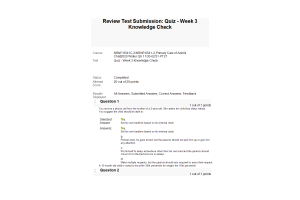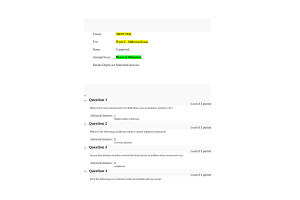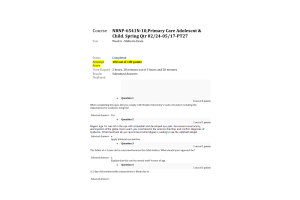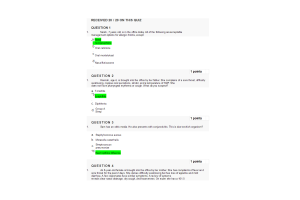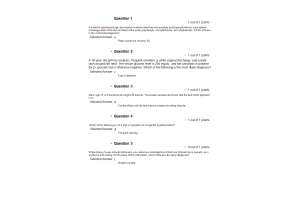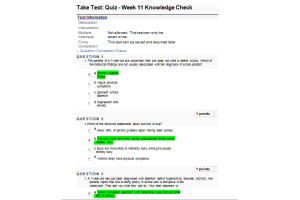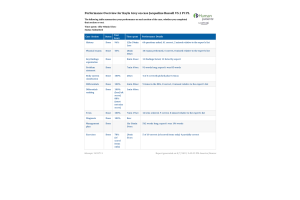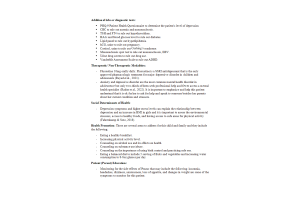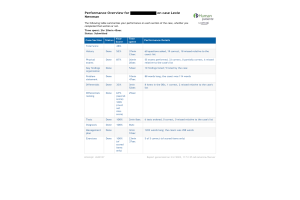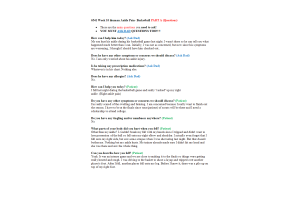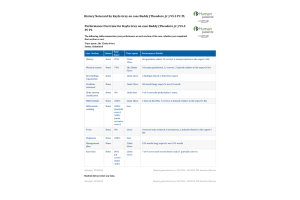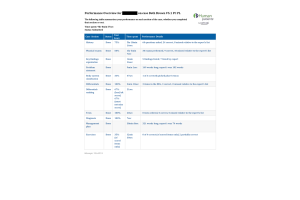NRNP 6541 Week 9 Quiz-Knowledge Check
- $20.00
- Question: What does shift to the left mean in a white blood count?
- Question: A 12-year-old male states he noticed an enlargement of his testes and scrotum. When counseling him about the next step in pubertal development, you state:
- Question: Which of the following would not suggest an eating disorder with a purging component?
- Question: Which of the following strategies would not be appropriate to include as part of your treatment plan of an 8-year-old boy who is obese?
- Question: Robert, your 15-year-old male patient, is here today for a well visit. He is tall in stature and has increased arm span, laxity of joints, pectus excavatum, and an abnormal echocardiogram. Which of the following diagnosis would you suspect Robert as having?
- Question: The most common presentation of Hirschprung disease is which of the following?
- Question: The most accurate way to determine the degree of dehydration in a vomiting child is to assess
- Question: John is 4 years old and in today for a well child visit. He is due for his 4- year-old immunizations. He was recently diagnosed with ALL and is being treated with chemotherapy and radiation. Which statement is true about immunizations during treatments during childhood cancer?
- Question: The following clinical description best matches which genetic disorder? A tall, thin 14-year-old boy has no signs of puberty. He was delayed in his speech development and always has done less well in school than his siblings. He is shy, and teachers report his activity is immature. Physical examination reveals breast development, and long limbs with a decreased upper segment/lower segment ration. He has small testes and phallus.
- Question: A mother brings a 2-year-old to your office with the complaint that she passes 5 to 10 watery stools per day that often contain undigested food. The child appears healthy and has no other GI symptoms. She is acting, eating, and voiding normally. Weight gain is normal and the mother states she often drinks (her favorite drink is Kool-Aid) instead of eating. The best management for this condition is:
- Question: Maddie, age 2, had a complete blood count (CBC) drawn at her last visit. It indicates that she has a microcytic hypochromic anemia. What should you do now at this visit?
- Question: Dave, age 17, has gynecomastia. You should also assess him for
- Question: Jennifer, age 16, is an active cheerleader who just developed type 1 diabetes. She is worried that she will not fit in with her friends anymore because she does not think she can have all the same snacks they have. How do you respond?
- Question: Josh, age 13, has some enlargement of the scrotum and testes, a reddened scrotal sac, and some hair texture alteration. His penis is not enlarged. He is in Tanner stage.
- Question: Which of the following is not a sign or symptom of congenital hypothyroidism?
- Question: Which malignancy is associated with genitourinary anomalies?
- Question: Hypercholesterolemia in children older than 2 is defined as a total cholesterol at or above
- Question: The appropriate lab tests in assessment of cervical adenitis include all of the following except:
- Question: A 14-year-old girl from another state was followed for 7 years for a history of insulin-dependent diabetes mellitus. Her hemoglobin A1C is 14.9%. This laboratory test indicates which of the following?
- Question: What does a low level of thyroid stimulating hormone (TSH) indicate?

